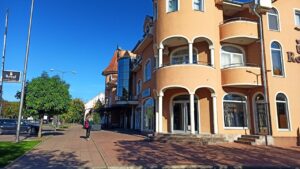How to solve the problem of high real estate prices in Subotica
Subotica, a charming city in northern Serbia, has been experiencing a surge in real estate prices that has left many residents and potential buyers scratching their heads. With its rich cultural heritage, beautiful architecture, and strategic location near the Hungarian border, it’s no wonder that demand for property in Subotica is on the rise. However, this increase in prices poses a significant challenge for locals and newcomers alike. In this article, we’ll explore some practical solutions to tackle the problem of high real estate prices in Subotica, aiming to create a more accessible housing market for everyone.
Understanding the Causes of High Real Estate Prices
Before we can address the issue of high real estate prices in Subotica, it’s essential to understand the factors contributing to this trend. One major reason is the influx of people moving to the city, drawn by job opportunities and the overall quality of life. As more individuals and families seek to settle in Subotica, the demand for housing naturally increases, leading to higher prices. Additionally, the limited supply of available properties exacerbates the situation, as developers may be hesitant to invest in new construction projects due to various economic uncertainties.
Another contributing factor is the growing interest from foreign investors. Subotica’s proximity to Hungary and its picturesque surroundings make it an attractive option for those looking to invest in real estate. This influx of foreign capital can drive up prices, making it even more challenging for local residents to find affordable housing. Furthermore, the lack of comprehensive urban planning and zoning regulations can lead to haphazard development, further complicating the housing market.
Lastly, the overall economic climate in Serbia plays a role in real estate prices. As the country continues to recover from past economic challenges, increased consumer confidence can lead to higher spending on property. However, this can also create a disparity between those who can afford to buy and those who cannot, widening the gap in the housing market and making it increasingly difficult for average citizens to secure a home.
Promoting Affordable Housing Initiatives
One effective way to address the issue of high real estate prices in Subotica is to promote affordable housing initiatives. Local government and private developers can collaborate to create housing projects specifically designed for low- and middle-income families. By offering incentives such as tax breaks or subsidies, developers may be more inclined to invest in affordable housing options, ultimately helping to balance the market.
Additionally, the city can explore the possibility of repurposing underutilized or abandoned properties. Transforming these spaces into affordable housing units can not only help alleviate the housing crisis but also revitalize neighborhoods and enhance the overall aesthetic of the city. Community engagement is crucial in this process, as residents can provide valuable input on what types of housing are needed and where they should be located.
Furthermore, implementing rent control measures can help stabilize the rental market and protect tenants from sudden price hikes. By capping rent increases and ensuring that housing remains affordable for residents, the city can create a more equitable living environment. This approach can also encourage landlords to maintain their properties, leading to improved living conditions for tenants.
Encouraging Sustainable Development Practices
Another approach to solving the problem of high real estate prices in Subotica is to encourage sustainable development practices. By focusing on environmentally friendly construction methods and materials, developers can create housing that is not only affordable but also energy-efficient. This can lead to lower utility costs for residents, making it easier for them to manage their monthly expenses.
Moreover, promoting mixed-use developments can help create vibrant communities that cater to various needs. By combining residential, commercial, and recreational spaces, these developments can foster a sense of community while also providing essential services within walking distance. This can reduce the need for extensive transportation, making it more convenient for residents and potentially lowering living costs.
Lastly, the city can invest in public transportation infrastructure to improve accessibility and connectivity. By enhancing public transport options, residents will have better access to job opportunities and amenities, making it easier for them to live in more affordable areas outside the city center. This can help alleviate pressure on the housing market and create a more balanced distribution of population and resources throughout Subotica.
In conclusion, addressing the issue of high real estate prices in Subotica requires a multifaceted approach that considers the underlying causes and promotes sustainable solutions. By focusing on affordable housing initiatives, encouraging sustainable development practices, and improving public transportation, the city can work towards creating a more accessible housing market for all residents. With collaboration between local government, developers, and the community, Subotica can continue to thrive while ensuring that everyone has the opportunity to call this beautiful city home.


